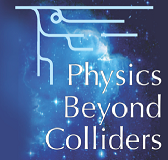Speaker
Description
Axions are a natural consequence of the Peccei-Quinn mechanism, the most compelling solution to the strong-CP problem. Similar axion-like particles (ALPs) also appear in a number of possible extensions of the Standard Model, notably in string theories. Both axions and ALPs woudl be copiously produced at the sun's interior, and in addition they are very well motivated candidates for the Dark Matter. They are object of increasing interest by experimentalists. A relevant effort during the last decade has been the CAST experiment at CERN, the most sensitive axion helioscope to-date. Here I will present an initiative born as a large-scale ambitious follow-up of CAST: the International Axion Observatory (IAXO). As its primary physics goal, IAXO will look for solar axions or ALPs with a signal to background ratio of about 5 orders of magnitude higher than CAST. For this IAXO envisions a large superconducting toroidal magnet designed optimizing the axion helioscope figure of merit, extensive use of x-ray focusing optics and low background x-ray detectors. IAXO will venture deep into unexplored axion parameter space, thus having discovery potential. IAXO has also potential to host additional detection setups. Most interestingly, the large magnetic volume of IAXO could be used to detect relic axion or ALPs potentially composing the galactic halo of Dark Matter. IAXO has the potential to serve as a multi-purpose facility for generic axion and ALP research in the next decade, making use of technology and know-how from CERN.
